Quality of Life and the “Solo-Living” Experience in New York City Research Report
Supanit Loharjun, Ifah Pantitanonta and Xiaoyu Wang
Individual Project: Design Research 2022 | Professor Putri Trisulo
MS Strategic Design And Management | Parsons School of Design | The New School
Introduction Problem Statement
Area of Exploration
Target Segment Defining ‘Solo-living’
Significances and Purposes
Research Questions
Methodology
Contextual Research Trend
Influencing Factors
Money Is The Driving Force.
Personal Goals & Values
Government Community
Key Takeaways
Findings Synthesis
Assessing Key Concept Of Opportunity
TABLE OF CONTENTS
01 02 PART PART 06 12
CONTENTS Quantitative Research Qualitative Research Interview Participants And Objectives Interview Summary Findings Synthesis Influencing Factors Diagram 2.0 Insights Opportunity Area Key Concept Co-Creation Workshop Identifying Opportunities Bibliography Appendix Link To Midterm Presentation Link To Final Presentation Deck Interview Respondents Summary Snapshots From Interview 03 04 05 PART PART PART 24 40 56
01 PART
Problem Statement
Area of Exploration
Target Segment
Defining ‘Solo-living’
Significances and Purposes

Research Questions
Methodology
6
Introduction
Problem Statement
Despite being a tough place to live, many people dream of living in New York City for job opportunities. The expense of living is high. People have to figure out their ways to live affordably. It’s becoming harder for people to settle in and find solid financial footing, especially for the solo-living women seeking independence but are framed by society to fall through much easier. They are facing multiple drawbacks, financially and emotionally, recognized and unrecognized. How might we improve the quality of living experience for solo-living women in New York City?
Area of exploration
We aim to understand the experiences of solo-living women in New York City and explore the concept of ‘affordability’ in another perspective.
7
Female and Transwomen
Gender
Target Segment
Single never been married, or any previous marriages were legally ended by death or divorce
Age
Status
Living Environment
20-35 years old
Live in New York City
Live alone or with roommate(s)
8
Defining Term
‘Solo-Living’
Someone who is or is seeking to be financially independent. Their official marital status is single; they are not legally bound to anyone– bearing the responsibility alone. They may or may not be in a committed relationship. ‘

9
Significances and Purposes
• New York City is ranked to have the most significant number of single women compared to other cities in the U.S., based on Bloomberg.1 This research will help find the factors and correlations that shape the context of the city and society.
• Many solo-living people are coping with everyday problems including financial, emotional, and mental issues due to multiple factors, both controllable and uncontrollable. By analyzing issues from emerging patterns, this research will help find insights to these factors that may help solo-living women improve their quality of life.
• New York City attracts people from everywhere around the world, different countries, cultures, backgrounds, and norms; given the fact of one the most diverse cities in the world, people come to this city for similar achievements, financial goals and life fulfillment. This research will help find the opportunity and gap to support this target group in achieving and offering opportunities for a better quality of life.
• American society is antagonistic toward single people. Taboo exists in society; there are the seen and unseen stigmas and discriminations against solo-living women. Not many people have addressed this issue seriously, e.g., judgment and unequal support from society, the workplace, and the government– unsupportive public policies.
Research Questions
To understand and improve the experiences of solo-living women responding to the changing world, the research will be guided by the following questions:
1. What values and experiences do the solo-living women have?
2. What are the factors that influence their quality of life?

3. How can we create affordable living experiences for solo-living women?
• Definition and decisionmaking behavior

• Measurement and parameter

10 1.Florida, “Single on Valentine’s Day? It Might Be Where You Live.”
Methodology
The secondary research materials for this study are online research and literature reviews, including articles, online blogs, academic papers, news, and case studies.

Primary research will be conducted through online surveys, the quantitative research, purposely to analyze patterns and interests, which will scope down the potential focus to assist the interview design. Qualitative research will be performed through interviews to develop an insightful understanding of the study. Data collection will be synthesized to identify interconnection and the overall framework. Once the problems are identified, opportunity areas will be outlined, leading to conceptual and future design solutions.
Secondary Research
Online Research
Literature Review
Primary Research
Quantitative Research
• Online Survey
Qualitative Research

• Target Group Interviews
• Expert Interviews
• Observations
• Opportunity Mapping Workshop
11
How might we improve the quality of living experience for solo-living women in New York City?
02 PART
Trend
The Influencing Factors
Money Is The Driving Force.
Personal Goals & Values
New York City

Job Opportunities
Physical City Structure
Living Aspect - The Diverse City
Living Aspect - Culture And Expectations Toward SoloLiving Women
• Single-Shaming
• Unseen Social Structure
Discrimination
Government
Current Policies Offered
Economic Risk
• Underrepresented And Unequal Pay
• Lifestyle, High Cost Of Living And Responsibilities
Community
What’s In The Market?
• Bumble
• Chief
Key Takeaways
Findings Synthesis
Influencing Factors Diagram
Assessing Key Concept Of Opportunity
12
Contextual Research


Trend: The Rising Number of Single Women
About one-third of the American people are single, and half of that one-third are not actively looking to date according to the PEW research center.2 It becomes more apparent that the majority of single people are in the younger age group from 18 to 29, making up about 41% of the population. As age increases, women are more likely to be single compared to men. The research has found that as women are likely to live longer,3 single women far exceed the number of men on the East Coast, New York has 230,000 single women more than men given that 1,072 single women per 1,000 single men.4

Women are likely to live longer than men
One-third of Americans are single
New York has 230,000 single women more than men
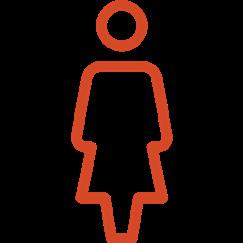
13
2. Brown, “A Profile of Single Americans.”
Show US
3. H, Shmerling MD, “Why Men Often Die Earlier than Women.” 4. Baer, “Maps
Cities Where Single Women Outnumber Men.”
>
The Influencing Factors
As solo-living women, they have to break through different events regarding their identity– gender, age, status, and living environment. These are the factors that influence their living experiences.
Goals & Value
Money
Lifestyle
Community
Social Norm/ Expectation

Discrimination
(Recognized and Unrecognized)
Society
Economy
Public Policy
New York City
• Physical Landscape
• Living Landscape (Diverse City, Job Opportunities)
Government
14
Economic Status
Career
Money Is The Driving Force For Quality Of Life.
It is hard to deny that money is not the driving force in many aspects of our lives, not while we are living in this capitalist society. Beyond basic survival, money gives the opportunity to live a healthier life and to have more positive relationships.5 Money has become the tool that assists the independent choices to quality of living.6 Talking about the quality of life is a highly subjective measure of happiness that is essential for many financial decisions. The decision is whether the tradeoff wherein saving, earning, or even money decreases or increases the quality of life.7
Quality of life
The data has shown that more than half of Americans are concerned about money and the economy, given that people look for a way to have certainty and security in finance.8
15
and
5. Squirrelers, “The Role of Money in Life.” 6. Maharjan and Hornburg 2021 7. Kagun, “What Is Quality of Life? Why It’s Important
How to Improve It.”
Money
Personal Goals & Values
According to College Generation, the survey data shows the top 3 essentialfactors to a good life for young professionals aged 26 to 40 are good health (66%), financial stability (63%), and healthy relationships (53%). The younger age group 18-25 prioritized, good health (57%), financial stability (52%), and healthy relationship (53%). Both age groups agree that when they are young, it is better to enjoy life and later enter the profession to secure financial stability.9 Specifically to single women, the survey has found 44% rate the ability to live on their own as the number one priority, 34% to establish a career, and 27% to have financial security.10 This suggests that single women aim to be fully independent.
New York City
Job Opportunities
Compared to other cities in the states, New York City remains popular in offering job opportunities, especially for the Millenials.11
In New York City, there's a diverse range of opportunities in different industries, e.g., finance, emerging tech, healthcare, fashion, media and culture, and real estate.12 Its economy would be the tenth-largest in the world. According to the New York State Department of Labor,13 the economy continues to grow, with 293,800 jobs between 2021 and 2022.
According to the Current Employment Statistics Program,14 among city residents and those commuting into the City, New York City gained a 2.1% increase from 2020. For comparison, the U.S. gained 2.8% of its jobs in 2021. The number is believed to increase following the policies and pattern shown years before gradually.

16
9. McNeally, “America Now: Life Priorities Across Generations.”
10. DePaulo, “What Single Women Really Want.”
11. Glodowski “Stats and the City: For millennials, New York is as popular as ever.”
12. NYC Economic Development Corporation, “Why NYC.”
13. New York State, “Labor Statistics for the New York City Region.”
14. City of New York, “2022 Income and Affordability Study - NYC.”
Physical City Structure
New York City has mixed-use neighborhoods where all activities of residential, commercial, retail, hospitality, and basic entertainment facilities are available. It is also a vibrant walking city, compact with high density, fine-grained public transport network, high volumes of pedestrians, and an efficient street grid. Public spaces also play a vital role. The city aims to create and enhance public spaces within a ten-minute walk from where people live. This is important as it improves its citizens’ mental and physical health, including creating a community within the area where people can congregate.15
Living Aspect - The Diverse City
As the city began to develop, new jobs opened up, and communities started to form. People of all cultures decided to settle in New York City.16 According to World Population Review 2020, New York City is the most diverse city17 in the world. Therefore, New York City is an extraordinary cultural diversity city filled with different traditions, food, backgrounds, events, and rooms for everyone.
Living Aspect - Culture And Expectations Toward Solo-Living Women
There are several misconceptions about single women in New York City, e.g., people believe they are lonely and desperately seeking relationships. These are the contradictions and anxieties women in New York City today might face. One example is in the popular TV series, Sex and the City, where Carrie Bradshaw, the lead character, mentioned, “In New York, they say you’re always looking for a job, a boyfriend, or an apartment.”18
Single-Shaming
The definition of single-shaming is negatively judging somebody for not being partnered up and not conforming to society’s expectations of being married at a certain age. Single shaming may correlate with higher probability of depression, according to psychotherapist Allison Abrams.19
520 of 1,000 single adults reported experiencing single shaming
Research show society to be more likely to pair married people with positive attributes, e.g., mature, stable, and honest. Meanwhile single people are paired with negative attributes, e.g., immature, self-centered, unhappy, unreliable, and irresponsible.20
Unseen Social Discrimination
Societal standards show the attitude towards ‘singlism.’ It is deeply embedded and unrecognized in the infrastructure of everyday life.21
Only 30% of singles said they felt discriminated against compared to the

17
16. Gehl, “World Class Streets: Remaking New York City’s Public Realm.”
17. Jennifer, “What Makes New York City So Diverse | Home Cleaning Services | Maid Service.” 18. Sex and the City Transcripts, “Sex and the City Season 5 Episode 5.” 19. Klein, Jessica, “‘Single shaming’: Why people jump to judge the un-partnered.” 20. Farrell,C, “What’s Wrong with Being Single: Lowered Relational Value Bias Toward Single People.”
100% of gays, 90% of obese, 85% of black, and 72% of women– singles do not consciously recognize that singlism is a valid form of discrimination even though there is evidence to support its existence.
Singles have little choice but to expend more in the areas out of practical necessity. The accessibility to benefits and advantages are often limited to only legally married people. This also applies to corporate benefits and incentives.
For example, a single woman earning $40,000 per year pays $6,181 in income taxes. A married woman earning $40,000 per year pays $5,162 in income taxes.22
At the same time, the public is more accepting of singlism than other forms of discrimination against different groups because it is perceived to be a controllable circumstance, whereas race and gender are perceived as uncontrollable.23
The culture places value on being coupled up, and regards singledom as undesirable, particularly for women. And it’s hard not to internalize this pressure, no matter how fulfilled the individual may be.24
Government
Current Policies Offered
Many of the structural privileges of partnership still revolve around the institution of marriage. Regarding the high number of married couples back then, many public policies— for example, taxes, IRAs, health insurance, and social security, were initially created according to the marriage majority; they were less beneficial to the singles because of the lower number. They are written to benefit married couples in the past but not for the increased difficulty that today’s single women face in balancing their careers and personal lives, including the struggle of cost burdens alone.25
In addition to the political dimension, ethically, feminist ethics holds that the history of ethics was created from a masculine perspective and relies on a range of assumptions that are not gender neutral.26 Among others, feminist philosopher Alison Jaggar27 faults traditional western ethics for failing women in five related ways. Above all, in comparison to men’s interests and rights, it demonstrates little consideration for women’s rights. This shows that women are not only unequal but also inferior in a male-dominated ethical system. Therefore, for single women, it is harder for them to manage economic risk as they are facing greater risk with fewer protections.
Economic Risks
Underrepresented And Unequal Pay
Through cultural stigma, being a single woman isn’t equally distributed. Women tend to endure the brunt of it more than
18
21. Farrell,C, “What’s Wrong with Being Single: Lowered Relational Value Bias Toward Single People.”
22. Girlboss, “The Hidden Costs Of Being Single.”
23. Farrell,C, “What’s Wrong with Being Single: Lowered Relational Value Bias Toward Single People.”
24. Sackville, Kerri, “Being single can feel like a failure, but shouldn’t.”
25. Petersen,H., and Jordan, “Being single and living alone is incredibly expensive.”
26. Simonsen, Jesper, and Robertson, “Routledge International Handbook of Participatory Design.”
27. Jaggar, M, “Feminist Ethics.”
28. Jessica Klein, “‘Single shaming’: Why people jump to judge the un-partnered.”
29. Huang, Jess, Krivkovich,Starikova, and Yee, “Women in the Workplace.”
men.28 According to the 2020 Women in the Workplace study, before COVID-19, women had slowly been making some progress in the workplace. Though the numbers were progressing slightly upward, women remain dramatically underrepresented, especially women of color. One in four women are considering leaving the workforce or downshifting their careers versus one in five men would consider the same. Women are feeling more pressure at work than men are,more exhausted and burned out.29
Women working full time in the U.S. are still paid just 83 cents to every dollar earned by men, and the consequences of this gap affect women throughout their lives.30 As a result of lower lifetime earnings, they receive less in Social Security and pensions. In terms of overall retirement income, women have only 70% of what men do.31
cities, along with Tel Aviv, Paris, and Singapore.33
According to a survey by GoBankingRates, the worst financial fear and stress for New Yorkers is the everyday costs of living,34 e.g., groceries and utilities. However, housing is another major concern, as the rents are increasing double as fast as wages– 3.9% rent increase to 1.8% wage increase.35
The cost of living for singles and married couples are also different in comparison. The spending patterns for the singles spend 6% more than married couples spend, but married couples earn 25% more in income than singles earn.36

Lifestyle, High Cost Of Living And Responsibilities
Regarding the rise of New York City’s popularity and density, the cost of living also climbs. The quality of life in New York City index by numbeo.com shows the cost of living index at 100.0 (Very High).32 It’s also among one of the most expensive
A study from The Ohio State University,37 married couples can have as much as four times the wealth of those who are single. That’s not only because they can combine their salarieWs but also because they can take advantage of the economic scale– sharing expenses and relying on one another’s health insurance once they get married. That allows married couples to build wealth more quickly than those that are single, divorced, or only living together romantically but separated financially. They also divide up responsibilities in financially beneficial ways. Married couples could depend on their partner’s income while they looked for work, allowing them to spend more time searching and be more selective for a higher-paid job.38
19
33.
30. AAUW, “On average, women in America are paid only 82 cents for every dollar paid to men. At the current rate of progress, the pay gap.”
31.
AAUW, “The Simple Truth about the Pay Gap.”
32.
Numbeo, “Quality of Life in New York, NY, United States.”
Economist Intelligence Unit, “Cost of Living Index 2021.”
34. Lisa, Andrew, “From Alabama to Wyoming: The Cost of Living Across America.”
35. Long, Grant, “The Widening Gap: Rents and Wages in New York City.”
36. Paulin, Geoffrey, “Household spending by single persons and married couples in their twenties: a comparison.”
37. Grabmeier, Jeff, “Divorce Drops A Person’s Wealth By 77 Percent, Study Finds.”
38. Linn, “Why Married People Tend to Be Wealthier: It’s Complicated.”
Community
What’s In The Market?
Meaningful Relationship - Bumble
New York City is one of the top most solo-living cities proven by a number of users in dating apps, and it has been continuously growing with 45 million active users last year. The fact shows that solo-living behaviors have become common in this city and there is a significant rising number of users each year.39

The rapid growth of Bumble is accomplished against the backdrop of a global surge in the number of dating app users and the number of apps.40 This indicates that singles are now increasingly using dating apps as a primary way to meet potential partners or friends.

Women Empowerment - CHIEF
Solo-living women are seeking more alternative support systems and the number of community-driven organizations to support women are rising. For example, CHIEF, an exclusive network focused on supporting women to thrive and become executive leaders compared to men.41
CHIEF aims to support more female executive positions in the top-tier organizations, which have always been led by men. It is tackling the problem of the society taboo of gender discrimination by fighting to reduce the gap of unequal pay for women compared to men, provide more chance for women to get a fair opportunity to become leader than men. Today, CHIEF has become the world’s first women-led billion-dollar success stories. Learning from this case study, it shows that community-driven organizations and companies can play a crucial role for this research purpose to become successful.42
20 39. Business of Apps, “Dating App Revenue and Usage Statistics (2022),” 40. Business of Apps, “Dating App Revenue and Usage Statistics (2022),” 41. Chief, “Women Have Always Been Powerful.” 42. Chief, “Women Have Always Been Powerful.”
Key Takeaways
Driving Factor(s) and Personal Fulfillment
• Multiple factors are put upon sololiving women, which may hinder achieving personal fulfillment.
• Everything revolves around money and monetary value. It is believed to be essential in attaining and navigating the individual’s life to personal fulfillme perspective.
Outdated System and Supports
New York City and What It Offers
• Despite the burdens of the high cost of living and lifestyle misconception, New York City provides rounded resources and opportunities for people to stay, physically, financially, and emotionally.
• Government revolves around patriarchy and married couples privileges. The reality of how people live has changed, as well as the rising numbers of solo-living people, but the government hasn’t yet kept pace with them, leading to unsupported public policies to cover and improve every aspect of their lives.
• This is partly due to the unsupported public policies, social structure revolving around patriarchy and married couples, the expectations and negative attributes towards singles, and overlooking this as a severe issue.
Expectations - Personal and External
• The personal expectations solo-living women set for themselves are to secure a career that allows them to be financially independent.
• Solo-living women are discriminated against– seen and unseen, by society which is deeply rooted in the social structure and how others perceive solo-living women. They often receive unequal treatment and benefits.
Community
• Community is a good catalyst to support solo-living women to have better quality of life.
21
Finding Synthesis
Influencing Factors Diagram

Dissecting factors that influence solo-living women
From a solo-living woman’s inner core–identity, values, and goals to what the government is involved in and provides to its citizens, we separated these factors from controllable factors and uncontrollable factors, respectively.
The factors were classified into the inner core of a solo-living woman— values and goals. The inner layers, identity, goals and values, are the factors a solo-living
woman has or holds onto. These elements present who they are and life expectations. The following layers, economic status and life choice, are the elements where the person has control over choices to support and draw their well-being. The uncontrollable factors, community, society, and government, lay the uncontrollable factors. These elements are what the person cannot directly control, which may support or antagonize their quality of life.
22 1.
Assessing Key Concept of Opportunity
Affordability
According to Merriam-Webster’s definition,43 affordable means being able to afford, a cost that is not too high, within someone’s ability to pay, and reasonably priced. The affordability may be varied for individuals, measuring based on their income. The affordability indexes give an idea of the standard of living or attractiveness of a given region or area. It is widely associated with housing as it is a common and most significant expense of the cost of living.44

What is good might be out of reach, and what is within reach might need better quality. The perfect balance is what works well and within reach. It may not perform perfectly, but it should do a good job, especially life’s essential needs, e.g., affordable housing and public benefits.
Money may be but a component in the system?
23 43. Merriam-Webster,
Definition & Meaning.” 44.
Ryan. 2022.
Index Definition.”
“Affordable
Eichler,
“Affordability
03 PART
Quantitative Research Objectives
Survey Participants
Survey Result Summary
• Key Takeaways
Qualitative Research
Target Group
• Objectives and Interview Participants
• Interview Highlights
• Finding Commonality

• Key Takeaways
• Archetypes
Experts
• Objectives and Interview Participants
• Key Takeaways
Findings Synthesis
Influencing Factors Diagram 2.0
24
Quantitative Research
Objectives
• To understand the experiences of solo-living women in New York City
• Behaviors and values, priorities, and goals
• To understand what defines the experiences of sololiving women in New York City
• Influencing factors
• To understand how their well-being is affected
• Inner self
• Quality of living experience
• To understand what ‘affordable’ means for solo-living women in NYC
• Definition and decision-making behavior
• Measurement and parameter– What could be considered affordable besides housing?
Survey Participants
• 84 out of 120 are solo-living women, age 20-35
• The average length of stay is 2-6 years or longer
• 51% Living in Manhattan
84
solo-living women, age 20-35 out of solo-living in New York City 120
25
Survey Result Summary
Top 3 Common Priorities
What define success?
we grouped all the responses into five topics to find what solo-living women define as a success. The top three ranks are Financial Status, including career, money, and career stability, Happiness, including a state of emotional well-being– independence, and Relationship, including friends, family, society, and community, respectively.


1. Work job stability, career advancement
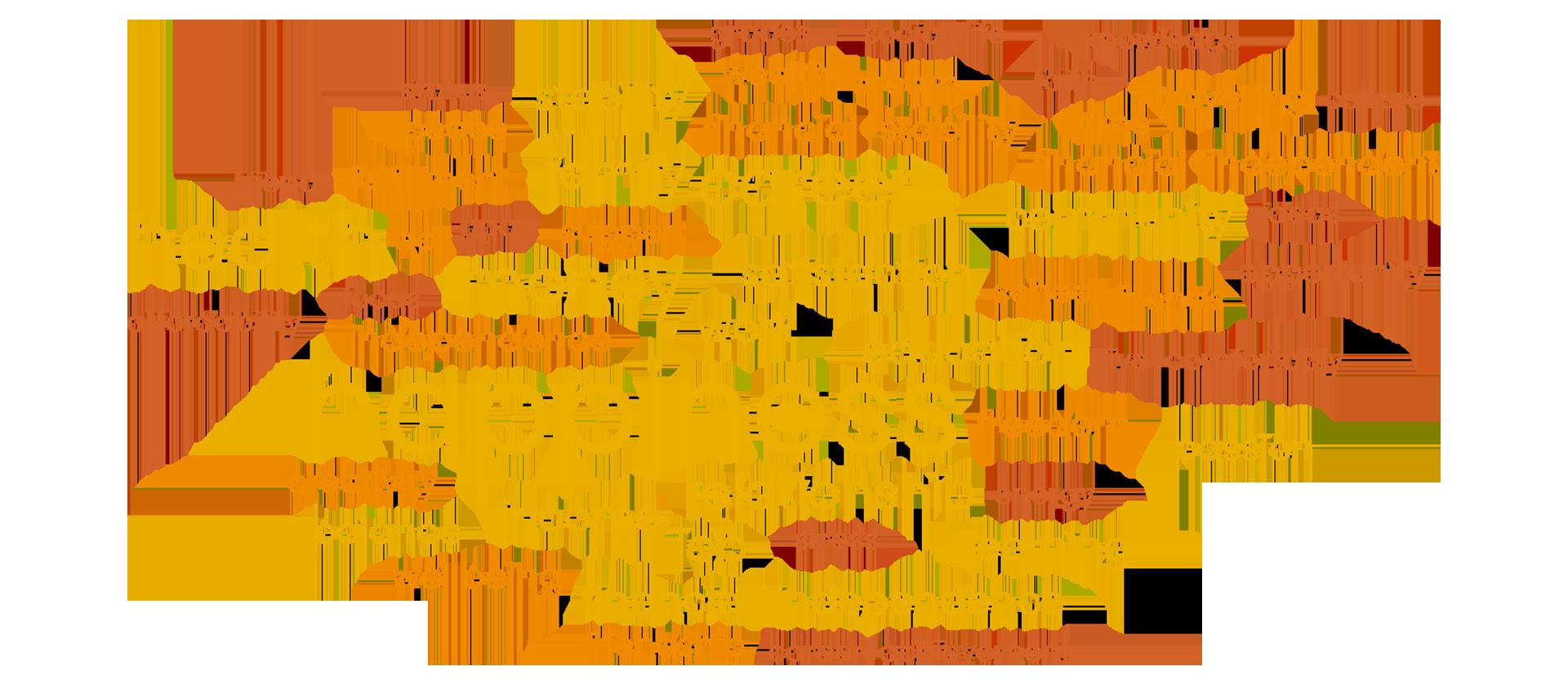
2. Money income, cost of living, expenses
3. Health & Safety
26
What costs are not affordable for the living experience?
According to the result, achieving Financial Status is the most prioritized success. The high cost of living could be a drawback to achieving the goals. Housing and Tax are two main concerns of the high cost of living for solo-living women.
Financial Status and the high cost of living issues in New York City have played a part in solo-living women’s lives. Housing could imply personal space, and Taxes could imply the benefit from the government– public policies; these two are the biggest concerns to the high cost of living expenses and are perceived as unaffordable. Expenses on these are unequal to the return received. Therefore, leading the solo-livings to prioritize Financial Status allows them to have stability, comfort, and a better quality of life.
Key Takeaways
• People strive to survive in New York City.
• People feel pressure from society to have a couple.
• The cost of living and salary in New York City are contradicted.

• Their priorities are toward self and future success with career, financial status, health and safety, respectively. Maintaining a state of emotional well-being and relationships with friends and family is also essential as one defining success.
• Affordability isn’t the only concern factor in people’s quality of life.
• People have a moderate concern about affordability toward other expenses (healthcare, utilities, food, groceries, entertainment). The housing market is very competitive and close to personal. Hence perceived as less affordable.
27
Qualitative Research
The qualitative research was conducted via 1-1 interviews with 10 solo-livings in New York City and 7 experts across different fields related to the driving factors of this target group. We also set the interview objectives as guidelines and prepared assets for the interview (questions guide) to help conduct interviews. The average time for the interviews lasted about 30-40 minutes. The following are the objectives.
Target group
• 10 Participants
• 7 Solo-living women
• 1 Solo-living LGBTQ+
• 2 Solo-living men
• 51% Living in Manhattan
Objectives
• To explore experiences and values
• To discover factors influencing their lives
• To dive into pain points
• To identify behaviors relating to affordability
28
Target Group Participants
Yasmeen H.
Income: $15/hour, partly support by family

Wachira L.

Income: $80K - 100K
Jidapa L.
Income: $100K - 200K

Shruthi T.


Income: Savings & Loans, partly support by family
Shambhavi M.
Income: $80K - 100K
Eric C. (Felicia)

Income: N/A
Nikki D.


Income: $80K - 100K
Nisboa W.


Income: > $100K
Samuel K.
Income: $80K - 100K
Peter B.
Income: > $100K
29 10 7 2 1 solo-living
Target Group Interview highlights
Support System
“Sometimes when you’re not feeling it, you should have a person or a friend to like a 5-minute call that could help make you feel better.”
— Wachira L.
Failed Public Policies
“Our policies need to update and catch on to the rest of the world, when it comes to public service and the civic infrastructure.”
- Nikki D.
Finding Commonality
Goals & Values
“You’re looking to them for love and care. You’re not looking to them for financial needs. I hesitate to outsource that, to anyone but myself. That’s a priority of mine for sure.”
— Shruthi T.
Sacrifices & Burdens
“I already sacrificed so much to get this job done. I sacrifice my mental health, taking time off for myself. And on the weekend I would like to be doing a lot more with my free time but I literally can’t because I have to do my assignment."
—Yasmeen H.
“The expectation of me as a single woman was to take like space in the house that was left after everyone else had picked. That felt discriminatory like my first wakeup call, this is how being single in a group of friends that are not single could be a problem, financially and emotionally.”
—Shruthi T.
After conducting the interviews, we gathered information and looked for common patterns and pain points, including extreme and outlying responses, to navigate the next step. We created tables to identify different aspects and topics.
Personal Value Aspect
Goals and Values
Among the respondents with less than 3 years of work experience, they are motivated but anxious. They are looking
to land on a secure job and ultimately be financially independent. While those with work experience more than 3 years tend to be in the stage of seeking advancement–financial stability, work, and living.
30
Living in New York City Experience and Expectation Aspect
High Cost of Living
New York City is the most expensive city (e.g., housing and groceries). The respondents with less than 3 years of work experience are aware of the high cost of living, leading to coping and managing different things in life at once. In comparison, a more extended living group focuses on managing long-term savings and their lifestyle.
Sacrifices
Regarding bearing a 1-person responsibility, the two groups have made many sacrifices, financially


31
and emotionally, to maintain their lifestyle as the solo-living woman in New York City and achieve their goals. Many sacrifices are due to external pressure from society, the workplace, the city, and the culture.
While the result shows the commonality of sacrifices taken among the solo-living women and men respondents, the social discrimination towards solo-living women has shown how they may have to put in more effort.
In addition to the interviews, research also shows that women have to make more significant financial sacrifices when desiring to achieve the same goal. For example, a single male would have to spend 32% of their monthly income to own a home, while women would have to spend an average of 49% of their income.45
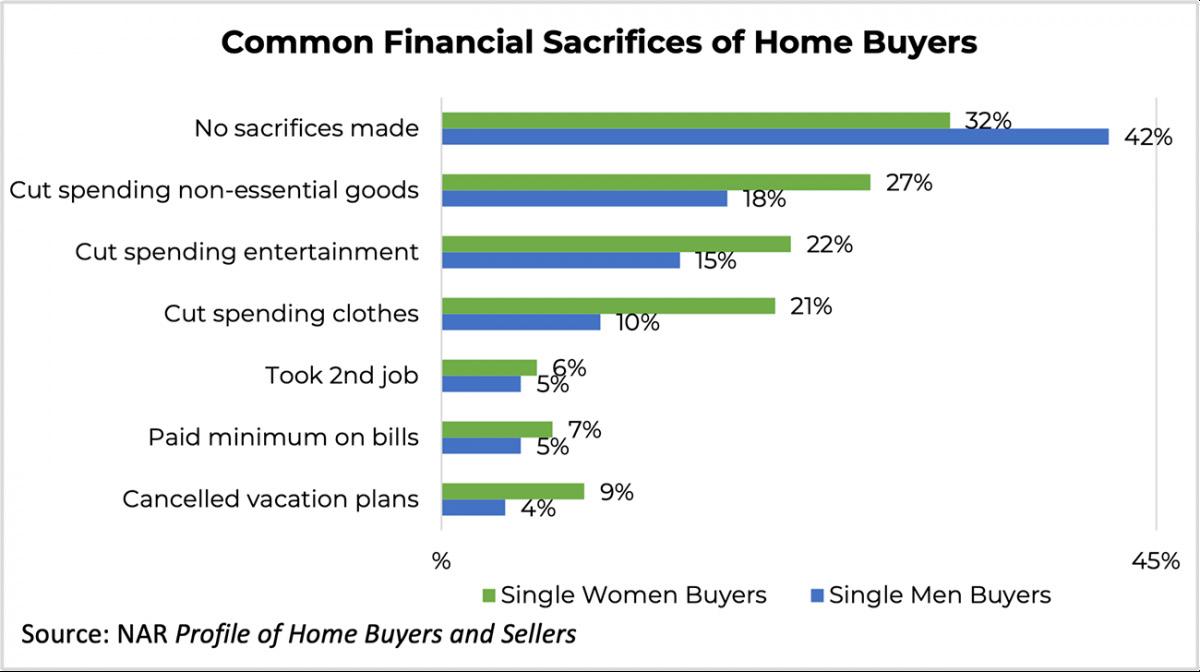
No Public Policies Support
When asked about how or where they seek support when facing specific issues, most respondents mentioned there isn’t sufficient support, they haven’t acknowledged the benefits, or they are not qualified to receive them. Solo-living women who are offered good benefits would typically get from the jobs they have.
Some public policies mentioned in the interviews include Affordable Housing Lottery, Food Stamps, Tax Breaks, and Healthcare.
Finding Extreme and Outlying
Extreme Behaviors
As a solo-living LGBTQ+ drag personnel, the there are additional discrimination against her career and identity. With that, she would need to find multiple support communities for her identity.
Outlying Behaviors– not corresponding with what was observed from the others
A common goal would be the aspiration to be financially independent and live comfortably, but some people mentioned their aim to create an impact beyond themselves, on the world. Bias and inequality toward ethnicity raised awareness and concern, but gender and status were mentioned by a few, which could indicate unrecognized discrimination.
32 45.
Horst,G, “Adversity Mounts for Single Women Seeking Homes.”
Target Group Interview


Key Takeaways
Goals & Values
Living in New York City provides job opportunities and high pay, leading to high passion and the goal of being financially independent, stable, and living comfortably.
Culture and Identity
• Being solo-living in New York City is common, and the city allows them to have freedom and socialize.
• Many don’t recognize the pressure of their identity, but some cultural expectations or social norms put puts many to question themselves financially and emotionally. Despite this being a major cause of significant sacrifices, there is unrecognized discrimination toward solo-living women.
Responsibility
• The 1-person responsibility— managing the cost of living alone, pursuing the goals, and proving themselves (and getting everything together) causes burdens and sacrifices. Balancing life becomes a factor to consider.
• Burdens and sacrifices include putting a lot of pressure on themselves, experiencing burnout, and losing different aspects of life, financial and emotional, and may affect their mental health.
Support System
• Solo-living women are afraid to fall back on their family and friends for financial support, but they still seek emotional and mental support from them and when possible, from the community.
• They seek external resources and support from the government, but public policies fail to deliver the acknowledgment, accessibility, and adequacy that support the basic


Decision Making
Rather than considering the monetary value, solo-living women determine the balance of best values in different aspects they will receive, including efficiency, quality, and time.


33
Archetypes
According to the interview summary, we identified goals, values, pain points, and needs across all the respondents into two archetypes– Emily, The Early Entry, and Stephanie, The Settling.
Emily The Early Entry
Work Experience: 0-3
Income Range: 0-50,000 maybe supported by sponsor(s)
Goal:
To have a career and be financially independent.
Self Financial Reliance:
Self Management:
1-Person Responsibility Concern:
Self and External Expectations:
Paint Points:
• Social pressure to have everything sorted out
• Fear of missing out on all the fun in the city
• Uncertain lifestyle, changes, and a lot of sacrifices, emotionally and financially
Needs:
Resources for career establishment and support in managing their major shift, financially and emotionally.

34
The two could be someone who aims for different aspirations with some overlaps, and that one with less living experience in New York City and as a solo-living woman could seek a smooth transition to the latter wellexperienced one. Moreover, each of them may provide resources and support to each other to reach their life fulfillment.
Stephanie The Settling
Work Experience:
Goal:
To have career advancement, explore more opportunities, and live more comfortably with savings.
Self Financial Reliance:
Self Management:
1-Person Responsibility Concern:
Self and External Expectations:
Paint Points:
• Too devoted to working and unable to balance time and energy
• What’s the next phase of life
• Social pressure to have someone to fulfill yourself or to be more successful in proving yourself
Needs:
Better living experience, financially and physically, and resources for maintaining well-being for herself and/with others.

35
3+ Income
50,000+
Range:
7

Experts
• 7 Participants
• 2 Urbanism
• 1 Sociology and Anthropology
• 1 Economic
• 2 Public Policies

• 1 Woman Empowerment
Target Group Participants
Sonam C. Social Worker at Hot Bread Kitchen Organization
Objectives
• To understand the insights of different fields addressing from desk research, survey, and interviews to be the key factors
• To discover opportunity areas
Watcharin K. Urban Planning Designer




Prof. Benjamin L. Sociology, Anthropology and Philosophy
Prof. Cecil B. Urban Designer and Architecture, University Professor


Christina C. Woman Activist and Journalist at Onely


Anonymous Expert Economic, University Professor
Susan X. Government Affordable and Welfare Housing Counsellor
36
Every expert commonly mentioned how being a solo-living woman is challenging, especially in New York City. Society– social norms, and the city are shaped not to support the status and lifestyle choices made by female individuals. Everyone has an equal right to live as they desire, happily and comfortably— a good quality of life. The discussions have pointed out different opportunity areas to improve their quality of life, prospects, and experiences, as well as the possibility to redefine 'affordability’.
Experts Interview Key Takeaways
Structure

The city should facilitate the balance between private development and public agenda to meet its population’s values and needs, whether it is an idea of public space, social services, or public policies to uplift their quality of life.
Rights to be supported

Regarding differences, support and accessibility should be equally distributed, e.g., affordable housing, income, and education. However, public policies advocating for inclusivity have yet to be directly or effectively doing their jobs. They are placed at the level to support only certain groups of people, long overdue to outdated values, e.g., males, married couples, and the upper class. Being single or solo-living is a personal decision, and no one should be involved. The government shouldn’t provide extra benefits to people who want to partner up.

Decision Making and Affordability
The decision made on the volatility of everyday life plays an important part in defining the quality of life, meaning there are other aspects beyond money to consider. And the way to perceive affordability doesn’t only rely on money but also on accessibility, compatibility, and functionality.
37
Findings Synthesis
Influencing Factors Diagram 2.0

From the influencing factors diagram previously illustrated in contextual research findings and the ones from qualitative research, additional factors have been identified associated with how a solo-living woman experiences.
Achieving every layer of factors takes time, energy, and emotion, especially for sololiving women having to sacrifice so much from all the drawbacks, both recognized and unrecognized. The intensity and capability of how much it takes varied from the inner core identity to the uncontrollable external layers. However, the crucial area is between Economic Status and Goals & Values. The area shows how important time, energy, and emotion are to the process and how much they are taken upon reaching the goals and values. Therefore, to sustainably maintain well-being, besides maintaining financial stability–money and career, solo-living women should consider balancing other aspects holistically. The idea could be put forth to define the true value of having a good quality of life.
38

39
Insights

Opportunity Area
Key Concept
Co-Creation Workshop
Identifying Opportunities
40
04 PART
Insights



Insight
Insight
Insight




41
01
goal is beyond money.
The
systems
essential.
02 Support
are
the unacceptable.
03 Accept
Insight 01
The goal is beyond money.
Contextual Research

Despite job opportunities and thriving to live in one of the most expensive cities in the world, living on their own is an ultimate goal for solo-living women.
The experiences and goals cannot be pursued easily with the inequality, economic risk, and opportunity offered against their identity.
Quantitative and Qualitative Research
Solo-living women want to be financially independent and further seek to live more comfortably to attain financial, career, and life advancement.

It is a heavy burden as a 1-person responsibility. They have to make significant sacrifices–financially, emotionally, and mentally. They consider different aspects when making decisions.

Insights
The ultimate goal is to be self-reliant, independent, and stable, not only financially but also in the aspect of balancing physical and emotional well-being holistically through living experience.
42
Insight 02

Support systems are essential.
Contextual Research
The physical city landscape and a sense of community could encourage solo-living women to connect with the community and improve their mental and physical health.
Quantitative and Qualitative Research

Friends and family play an important role in supporting solo-living women. They seek them not for financial support but for emotional and mental support.
New York City facilitates little sense of belonging.
Insights
Solo-living women are seeking resources and support to navigate their burdens—physically and mentally. The support can be friends, family, and community, as they can provide a sense of reliability, comfort, and belonging.
43
Contextual Research
Inadequate government support and social discrimination toward solo-living women.
The accessibility to public policies and benefits is often patriarchal and limited to only legally married people, consequencing negative attributes toward solo-living women.
Quantitative and Qualitative Research
As solo-living women by choice or circumstance, they face social stereotypes and stigmas, recognized and unrecognized, leading them to become financially and mentally drained.
They seek support from the government, but public policies fail to deliver the acknowledgment, accessibility, and adequacy that support the basic needs— housing, food, health, and safety.
Insights

On top of being resilient and unrecognizing the discrimination, sololiving women have to accept the social structure that doesn’t accommodate them, partially resulting from the public sector putting less priority on their status and gender.

44
Insight 03 Accept the unacceptable.
Insights Overview


The ultimate goal is to be self-reliant, independent, and stable, not only financially but also in the aspect of balancing physical and emotional well-being holistically through living experience.




Solo-living women are seeking resources and support to navigate their burdens—physically and mentally. The support can be friends, family, and community, as they can provide a sense of reliability, comfort, and belonging.
On top of being resilient and unrecognizing the discrimination, sololiving women have to accept the social structure that doesn’t accommodate them, partially resulting from the public sector putting less priority on their status and gender.

45
Insight 01
The goal is beyond money.
Insight 02
Support systems are essential.
Insight 03 Accept the unacceptable.
In summary, it's not just a personal aspiration but also a breakthrough in the unseen pressure of status. It's about receiving the resources and support that could facilitate them to that life fulfillment.
Opportunities Area
Key Concept - New Affordability
Leading to the concept
“Financial decision making, under uncertainty because of financial issues, weighing the ups and downs together with the range of the choices that's very important in finance. It turns out to be a financial revolution. It’s not about making money, it’s about dealing with the volatility of everyday life.”
— Professor Benjamin L. Anthropology and Philosophy Professor
People encounter decision-making with the fluctuations that happen in daily life, the financial aspect may be a significant consideration in the decision-making process through the ups and downs, but the range of choices also plays another huge role. People are dealing with a wide range of options, which may not only relate to monetary value. Weighing the decisions of choices holds other matters that will impact the direction of their lives and living experiences.
46
Redefined Affordability
To redefine affordability, monetary value is no longer the only factor to be considered to improve the quality of life for solo-living women. Affordability is decision-making regarded within the scope of prioritizing and finding the balance of other aspects of life, unmeasurable value, e.g., time, energy, emotion, and experience.
affordability ≠ money
affordability = unmeasurable value
Current Affordability
Redefined Affordability
Money Money
Life Fulfillment
Time
The findings from the research lead us to the insights and an opportunity area that would be most compelling and impactful for solo-living women. To proceed, we set an HOW MIGHT WE that would help identify the opportunities, considering the concept of 'new affordability' as a core.
How might we fill the gap of stability for solo-living women in New York City?
47
Energy Emotion
Life fulfilment
Co-Creation Workshop
The purpose of the co-creation workshop is to explore how to improve the living experience of solo-living women by including peers and target audiences in ideation to identify the opportunity area further.

Methodology
We asked the participants to separate into two groups and role play as our archetypes–Emily (The Early Entry) and Stephanie (The Settling). We briefly explained to them the background and scenarios of the two archetypes in daily life, including introducing the new affordability concept. Then, we asked questions they would answer and write their ideas on post-its. The questions are as follows:
• What can be changed or provided at the Policy & Society Level for you to be more stable? E.g., Tax, Housing, Workplace, Healthcare, Society Awareness, Infrastructure, Economy, Safety
• Who or where are you reaching out to for support? What do you expect them to provide for you?
• What are the things that you are currently happy and satisfied with? (This question is to determine the possibilities of the opportunities from the previous questions.)
In the end, they were asked to rank the top 3 ideas that would be most impactful to provide stability for their living experience, to see the priority and opportunity of which area to tackle. They also shared their thoughts and summaries of their ideas.
48
The ideas from the co-creation workshop are as follows.
Both archetypes could get support from the government and society, e.g., promote inclusivity, programs to embrace individuality, the right to choose their person to partner up, and offer tax breaks. While at the community level, they are looking for family and friends. As well as the community, e.g., people who are facing similar issues or are well-experienced (other Emilys and Stephanies), employers, and landlords, to be more supportive, understanding of the circumstances, share and give advice.
The results suggested that solo-living women prioritize their needs from government and society while having community support could be beneficial to initially access the resources and supports, as the relationships are bonded more easily. The ideas will be used further to identify opportunities and develop final design solutions.


49
Identifying Opportunities
All three insights are situated on the influencing factors diagram to identify at which factor and level each is relevant and could further notably explore the opportunities.
As a result of the co-creation workshop and group brainstorming taken from the contextual, quantitative, and qualitative findings and insights, we identified what opportunities each level and relevant factors could articulate to fill the gap of stability, concerning the issues, and take apart from improving monetary aspects.

50
Insight 01 The goal is beyond money Insights Influencing Factors Diagram 2.0 Society & Government Community Personal Insight 02 Support systems are essential Insight 03 Accept the Unacceptable
Personal Level
Insight 01
The goal is beyond money
Embrace independency, self actualization, and satisfaction
Encourage and practice selfexploration
Improve holistic selfmanagement
Community Level
Insight 02
Support systems are essential
Provide a sense of reliability, comfort, and belonging
A mentorship program to exchange, give advice, and learn from one another
Society & Government Level
Insight 03
Accept the Unacceptable
More inclusive conversation and communication strategy among public sectors
Promote transparent and equal benefits to and for everyone
Connect and support among solo-living women themselves
Empower and raise awareness of the issues among themselves and the society
Organize and articulate their broader personal and policy needs
Create more accessibility to information and benefits
Generalize social norms and behavior toward solo-living women
Integrate well-being to improve the quality of life
51
We then created the opportunity area framework, which shows the correlations between each level– government and society, community, and personal. The identified opportunities are addressed in the framework considering which factor could be involved. The overlaps display that multiple factors could take part and create an impact. Moreover, the framework also implies that the area with various opportunities could potentially contribute the most impact for solo-living women, which here is densely addressed around the community.

The influencing factors diagram was later used to support the area of intervention, accentuating the overarching opportunity to move forward during the final design solution. There, rather than the initial matrix of how much a solo-living woman could take control of each factor, we looked at another perspective. We put the matrix of the impact intensity level– how intensive each factor plays a role in affecting a living experience of a solo-living woman, including
the issues. Government and its relevant activities at the outer layer show how it impacts other layers underneath to put burdens onto a solo-living woman. Securing the opportunities at the government and society level would create the most impact broadly and sustainably, yet might lessen the actionable aspect. On the other hand, focusing on the opportunities area at the personal level would be abruptly evident, yet impact only the individual and might
52
Looking from another persepective
Point of Intervention
Society & Government


53
not solve the root cause. However, the community is in between the other two. It can be considered the bridge creating progressive impact toward the government, society, and personal levels. Hence the area of intervention that would fill the gap of stability for sololiving women. In addition, the overarching opportunity lies within the scope and core of the community. Community Personal
Most impact opportunities area

In conclusion, the overarching opportunity may embrace community building to benefit equal rights for everyone, generalize the social norms, encourage self-exploration and satisfaction.
It could be implemented as a platform or a program where community building, e.g., collaborative and mentorship program, among themselves and the society, provides a sense of belonging, broader needs, and empowerment to support solo-living women to have a better quality of life– through the balance of beyond monetary value.
54
How might we build community and a sense of belonging to empower and support solo-living women among themselves and society?
55
Bibliography
Appendix
Link To Presentation
Interview Respondents Summary
Snapshots From Interview
Discussion Guide
Survey Report Summary
56
05 PART
Bibliography
AAUW. n.d. “The Simple Truth about the Pay Gap.” AAUW. Accessed October 4, 2022. https://www.aauw.org/resources/research/simple-truth/.
American Psychological Association. n.d. “Infographic: Stress about money and economy is on the rise.” American Psychological Association. Accessed September 30, 2022.
https://www.apa.org/news/press/releases/stress/2022/infographic-money-economy.
Baer, Drake, “Maps Show Cities Where Single Women Outnumber Men.” Business Insider. 2015. https://www.businessinsider.com/maps-show-cities-where-single-women-outnumber-men-2015-2.
Brown, Anna. “A Profile of Single Americans.” Pew Research Center’s Social & Demographic Trends Project, October 2, 2020. https://www.pewresearch.org/social-trends/2020/08/20/a-profile-of-single-americans/.
Chief. “Women Have Always Been Powerful.” Chief. Accessed September 12, 2022. https://chief.com/.
City of New York, “2022 Income and Affordability Study - NYC.” Rent Guidelines Board. 2022. https://rentguidelinesboard.cityofnewyork.us/wp-content/uploads/2022/04/2022-IA.pdf.
DePaulo Bella, “What Single Women Really Want,” Psychologytoday, July 2, 2018. https://www.psychologytoday.com/us/blog/living-single/201807/what-single-women-really-want
Economist Intelligence Unit, “Cost of Living Index 2021.” Economist Intelligence Unit. Accessed October 4, 2022. https://www.eiu.com/n/campaigns/worldwide-cost-of-living-2021/.
Eichler, Ryan. 2022. “Affordability Index Definition.” Investopedia. https://www.investopedia.com/terms/a/affordability-index.asp.
Farrell, Darian C, “What's Wrong with Being Single: Lowered Relational Value Bias Toward Single People.” Loyola eCommons. 2018. https://ecommons.luc.edu/cgi/viewcontent.cgi?article=4747&context=luc_theses.
Florida, Richard. “Single on Valentine's Day? It Might Be Where You Live.” Bloomberg. Bloomberg, February 14, 2019. https://www.bloomberg.com/news/articles/2019-02-14/single-on-valentine-s-day-it-might-be-where-you-live.
Gehl, “World Class Streets: Remaking New York City's Public Realm.” Issuu. 2014. https://issuu.com/gehlarchitects/docs/issuu_561_new_york_world_class_stre.
GIRLBOSS, “The Hidden Costs Of Being Single.” Girlboss. Accessed October 4, 2022. https://girlboss.com/blogs/read/costs-of-being-single.
Glodowski, Amanda. “Stats and the City: For Millennials, New York is As Popular As Ever.” Crain's New York Business. 2022. https://www.crainsnewyork.com/stats-and-city/millennials-new-york-popular-ever.
Grabmeier, Jeff. “Divorce Drops A Person's Wealth By 77 Percent, Study Finds.” Ohio State News. 2006. https://news.osu.edu/divorce-drops-a-persons-wealth-by-77-percent-study-finds/.
Horst, Kyle G, “Adversity Mounts for Single Women Seeking Homes.” theMReport.com. 2022. https://themreport.com/daily-dose/04-12-2022/adversity-mounts.
Huang, Jess, Alexis Krivkovich, Irina Starikova, and Lareina Yee, “Women in the Workplace.” McKinsey. 2022. https://www.mckinsey.com/featured-insights/diversity-and-inclusion/women-in-the-workplace.
Jaggar, Alison M. “Feminist Ethics.” In Encyclopedia of Ethics, eds. Lawrence Becker and Charlotte Becker. New York: Garland Press. 1992. Jennifer. “What Makes New York City So Diverse.” Planet Maids. 2022. https://planetmaids.com/what-makes-new-york-city-so-diverse/.
Klein, Jessica.“'Single Shaming': Why People Jump to Judge the Un-partnered.” BBC. 2022. https://www.bbc.com/worklife/article/20220405-single-shaming-why-people-jump-to-judge-the-un-partnered.
Lisa, Andrew, “From Alabama to Wyoming: The Cost of Living Across America,” GOBankingRates. 2021. https://www.gobankingrates.com/saving-money/home/cost-of-living-by-state/.
McPhearson, Timon, Christopher Kennedy, Bianca Lopez, and Emily Maxwell. “Parks are Critical Urban Infrastructure: The Use of Urban Green Space in New York City During COVID-19 – The Nature of Cities.” The Nature of Cities. 2020. https://www.thenatureofcities.com/2020/10/06/parks-are-critical-urban-infrastructure-the-use-of-urban-green-space-in-newyork-city-during-covid-19/.
Maharjan, Biliz. “Money Is a Tool. Freedom Is the Goal.” Medium. Writers' Blokke, November 27, 2021. https://medium.com/writers-blokke/money-is-a-tool-freedom-is-the-goal-8d03a082e9f9.
Merriam-Webster. n.d. “Affordable Definition & Meaning.” Merriam-Webster. Accessed October 5, 2022. https://www.merriam-webster.com/dictionary/affordability.
Numbeo. “Quality of Life in New York, NY, United States.” Cost of Living. 2022. https://www.numbeo.com/quality-of-life/in/New-York.
NYCEDC. n.d. “Why NYC.” NYC Economic Development Corporation. Accessed October 4, 2022. https://edc.nyc/why-nyc.
NYState Department of Labor. “Labor Statistics for the New York City Region.” Department of Labor. Accessed October 4, 2022.
https://dol.ny.gov/labor-statistics-new-york-city-region#:~:text=Labor%20Statistics%20for%20the%20New%20York%20City%20 Region,by%20379%2C300%20over-the-year%20to%203%2C541%2C900%20in%20April%202021.
Paulin, Geoffrey, “Household spending by single persons and married couples in their twenties: a comparison.” Bureau of Labor Statistics. 2011.
https://www.bls.gov/cex/anthology11/csxanth6.pdf.
Perry, Mark J., and HL Mencken.“Understanding America's Enormous $20.6T Economy by Comparing US Metro Area GDPs to Entire Countries.” American Enterprise Institute. 2019.
https://www.aei.org/carpe-diem/understanding-americas-enormous-20-6t-economy-by-comparing-us-metro-area-gdps-to-entire-countries/.
Petersen, Anne H., and Daniela Jordan. “Being Single and Living Alone is Incredibly Expensive.” Vox. 2021. https://www.vox.com/the-goods/22788620/single-living-alone-cost.
Sackville, Kerri, “Being Single Can Feel Like a Failure, But Shouldn't.” Sydney Morning Herald. 2019. https://www.smh.com.au/lifestyle/life-and-relationships/being-single-can-feel-like-a-failure-but-shouldn-t-20190402-p51a2v. html.
“Sex and the City Season 5 Episode 5.” n.d. Sex and the City Transcripts. Accessed October 4, 2022. https://www.satctranscripts.com/2008/08/sex-and-city-season-5-episode-5.html#.Yzz4Vi2cbOQ.
Shmerling, Robert H., MD. “Why Men Often Die Earlier than Women.” Harvard Health, June 22, 2020. https://www.health.harvard.edu/blog/why-men-often-die-earlier-than-women-201602199137.
Simonsen, Jesper, and Toni Robertson. “Routledge International Handbook of Participatory Design. New York: Routledge.” 2013.
World Population Review. “New York City, New York Population 2022.” World Population Review. 2022. https://worldpopulationreview.com/us-cities/new-york-city-ny-population.
Appendix
Links to Presentation
Midterm Video Presentation
Final Presentation Deck
Final Presentation Video Record

Inteview Respondant Summary




61





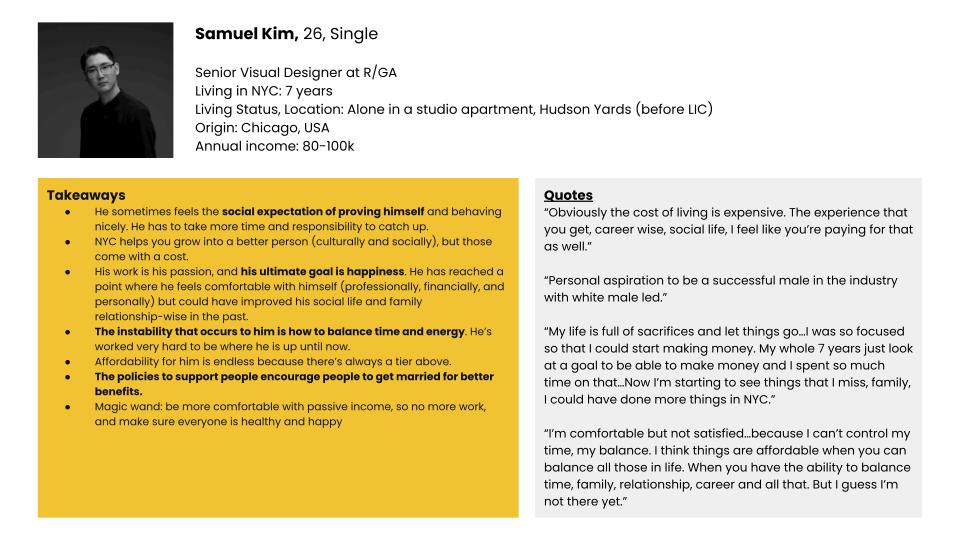

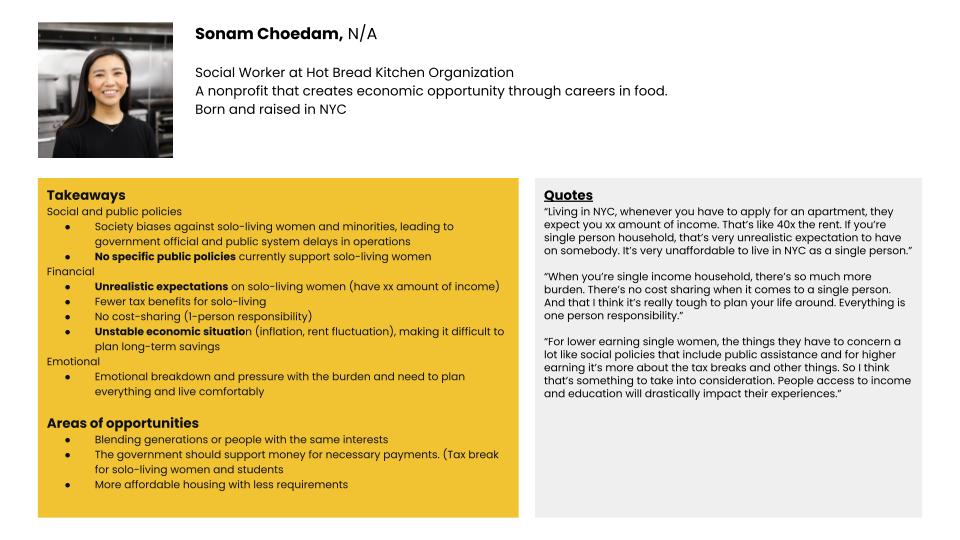
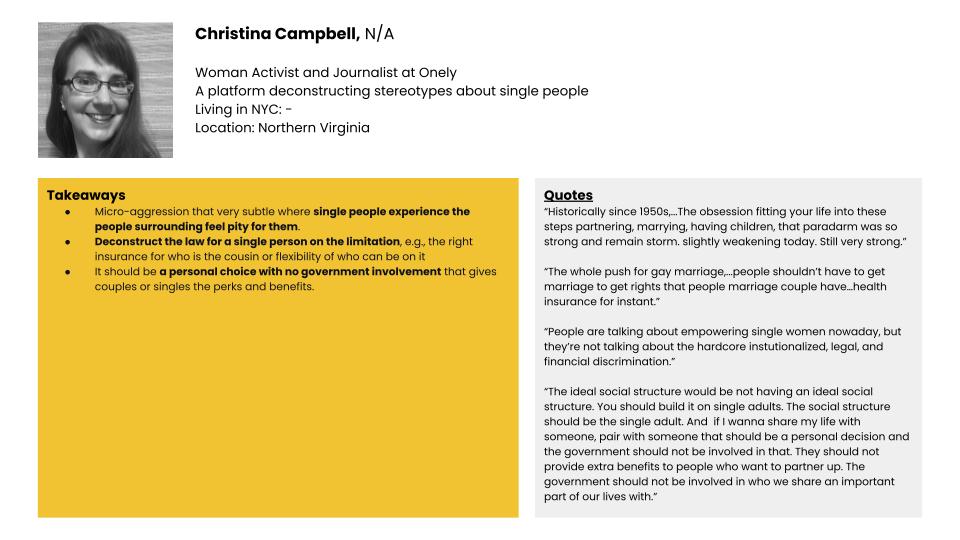

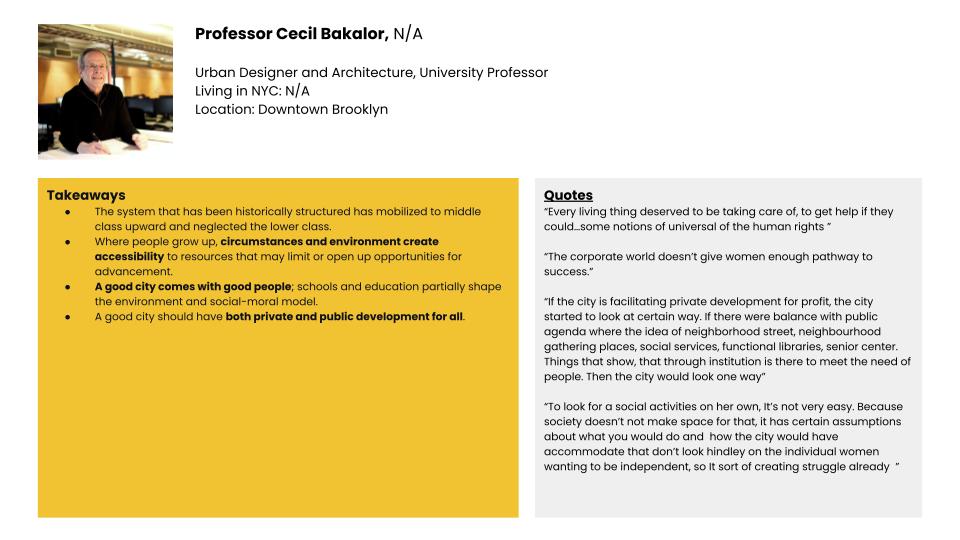

Snapshot from Interviews
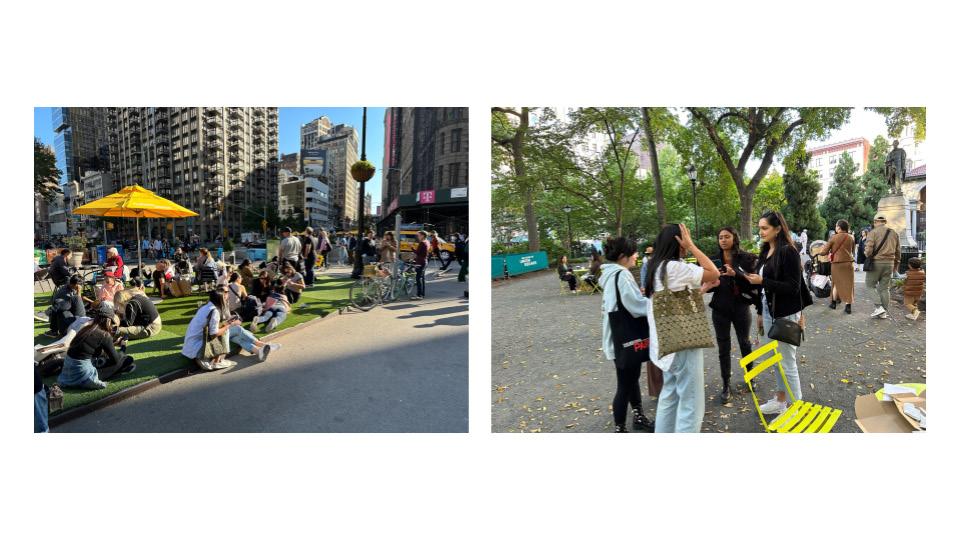



Discussion Guide with Target Group
Definition
Starter questions
0 Solo-living is someone who is seeking for financially independent (earning their own income) and is not in a committed relationship
0 How long have you been living in NYC? Would you mind sharing your annual income?
1 What does your typical day look like?
2 What is your background? Can you tell us a little bit about yourself (status, living conditions, etc )
Solo-living
Mindset
3 What is it like being solo-living in NYC?
4 What is the best part?
5 What is the most challenging? (e g , loneliness, cost of living, societal expectations/judgment, policies - inequality, healthcare, benefit, etc )
6 Compared to where you were from, are there any differences?
7 Despite the challenges, what makes you decide to stay in NYC? Do you see yourself living here forever?
Goal/Value
8 As a solo-living, what are you looking to achieve while living in NYC? What is your priority?
9 Why does it matter to you? e g , a tool to achieve something or an ultimate goal
10 Would you rather give up something in life to achieve that?
11 How does being solo-living woman impact other areas of your life/priority?
12 How do you manage the other areas of your life while living in NYC? (e g , social, health, financial)
Well-being
Behavior
13 Is it important to balance out your priority and the others?
14 What do you do to maintain your emotional and physical well-being and make this solo-living in NYC easier?
Affordability/Decisi
on Making Behavior
15 As a solo-living in NYC, do you feel like you're having a good quality of life? Are you stable with your living situation? (e.g. financial, economic, relationship)
16
Do you feel comfortable living here? What are the ways to make yourself comfortable?
17 What are the factors that you take into account when making decisions to make yourself comfortable?
Support
18 Do you have to sacrifice something for that?
19 How convenient/accessible is it for you to own/purchase something in NYC? (e g , housing, healthcare, tax, etc ) Why?
20 Does being a solo-living make any difference?
In your definition, what does 'affordable' mean to you? What would determine an 'affordable' life?
Do you find living in NYC affordable? How are you currently managing that? How much are you considering affordability as a factor in your daily routine?
21 Do you think living in NYC has all the resources or policies to support your good quality of life as a solo-living woman? Why?
22 Have you ever reached out to anyone or anywhere for support? (e g , personal, emergency situation, financial problem)
Closing
23 If you had a magic wand, what would you want to do with your life? What do you wish to be improved?
24 Are you satisfied with your quality of living right now? Explain why?
Discussion Guide with Solo-Living/those who are not exactly the target group
Definition
Starter questions
0 Solo-living is someone who is seeking for financially independent (earning their own income) and is not in a committed relationship
0 How long have you been living in NYC?
1 What is your background? Can you tell us a little bit about yourself (status, age, living conditions, etc )
2 What does your typical day look like?
Solo-living
3 What is the best part of being solo-living in NYC?
4 What is the most challenging? (e g , loneliness, cost of living, social expectation, policies - inequality, healthcare, benefit, etc )
5 Despite the challenges, what makes you decide to stay in NYC? Do you see yourself living here forever? How long?
Goal/Value
6 As a solo-living, what are you looking to achieve while living in NYC? What is
your priority?
7 Why does it matter to you? e g , a tool to achieve something or an ultimate goal
8 Would you rather give up or sacrifice something in life to achieve that?
Well-being 9 How do you manage the other areas of your life while living in NYC? (e g , social, health, financial, the responsibility you have right now)
10 Is it important to balance out your priority and the others areas? (work-life balance)
Behavior 11 What do you do to maintain your emotional and physical well-being and make this solo-living in NYC easier?
Affordability/Decisi on-Making Behavior
12 As a solo-living in NYC, do you feel like you're having a good quality of life? Are you stable with your living situation? (e g , financial, economic, relationship)
13 What are the factors that you take into account when it comes to making decisions when purchasing something to make yourself comfortable? (buy food/services/housing choice)
14
15
In your definition, what does 'affordable' mean to you? What would determine an 'affordable' life?
Do you find living in NYC affordable? How are you currently managing that? How much are you considering affordability as a factor in your daily routine?
Support 16 Do you think living in NYC has all the resources or policies to support your good quality of life as a solo-living? Why?
Closing 17 If you had a magic wand, what would you want to do with your life? What do you wish to be improved?
18 Are you satisfied with your quality of living right now? Explain why?
Affordable Living
Survey Report Summary
https://ujq6oi1l0xw.typeform.com/report/b9hTcrO6/G2EeIgawzEyo5tXh?view_mode=print
1/24
120 responses Gender 120 Female 88 resp. 73.3% Male 31 resp. 25.8% Prefer not to say 1 resp. 0.8% Non-binar y/non-conforming 0 resp. 0% Transgender 0 resp. 0% out of 120 answered
https://ujq6oi1l0xw.typeform.com/report/b9hTcrO6/G2EeIgawzEyo5tXh?view_mode=print 2/24 Relationship Status 120 Single 80 resp 66 7% In Relationship 38 resp. 31.7% Divorced or Separated 2 resp 1 7% Single-parent 0 resp. 0% Widowed 0 resp 0% out of 120 answered 10/18/22, 5:20 PM Affordable Living Please share your annual income 120 No Income 27 resp 22 5% $20,000 or less 20 resp. 16.7% Between $20,000-$50,000 18 resp 15% Between $80,000 - $100,000 18 resp. 15% More than $100,000 17 resp 14 2% Between $50,000-$80,000 12 resp. 10% More than $200,000 8 resp 6.7% out of 120 answered
https://ujq6oi1l0xw.typeform.com/report/b9hTcrO6/G2EeIgawzEyo5tXh?view_mode=print
4/24
is your source of income? 120 Self 73 resp. 60.8% Parents 31 resp. 25.8% Both 14 resp. 11.7% Partner/Spouse 0 resp. 0% Other 2 resp. 1.7% out of 120 answered
What
https://ujq6oi1l0xw.typeform.com/report/b9hTcrO6/G2EeIgawzEyo5tXh?view_mode=print
5/24 What industr y do you work in? 119 Student 43 resp 36 1% Creatives/Design 23 resp 19 3% Technology 12 resp 10 1% Finance 11 resp 9 2% Food and Hospitality 7 resp 5 9% Entertainment 5 resp 4 2% Health care 4 resp 3 4% Professional Ser vices 3 resp 2 5% Education 2 resp 1 7% Information ser vices 2 resp. 1 7% Militar y 0 resp. 0% out of 120 answered
https://ujq6oi1l0xw.typeform.com/report/b9hTcrO6/G2EeIgawzEyo5tXh?view_mode=print
6/24 Other 7 resp. 5.9% What is your ethnicity? 120 A sian 90 resp. 75% Caucasian 16 resp 13.3% Latino or Hispanic 9 resp 7.5% African-American 3 resp 2.5% Native Hawaiian or Pacific Islander 0 resp 0% Prefer not to say 0 resp 0% Other 2 resp 1.7% out of 120 answered
https://ujq6oi1l0xw.typeform.com/report/b9hTcrO6/G2EeIgawzEyo5tXh?view_mode=print
7/24
do you live? 120 Manhattan 61 resp. 50.8% Brooklyn 23 resp. 19.2% Queens 19 resp. 15.8% Staten Island 2 resp. 1.7% The Bronx 2 resp. 1.7% Other 13 resp. 10.8% out of 120 answered 10/18/22, 5:20 PM Affordable Living How long have you been living in New York City? 119 2-5 years 60 resp 50 4% less than 1 year 35 resp 29 4% 6-10 years 13 resp 10 9% more than 10 years 11 resp 9 2% out of 120 answered
Where
How long do you intend to stay in New York City?
https://ujq6oi1l0xw.typeform.com/report/b9hTcrO6/G2EeIgawzEyo5tXh?view_mode=print
9/24
119 2-3 years 39 resp. 32.8% 4-6 years 30 resp. 25.2% Forever (l love NYC) 19 resp. 16% 7-10 years 11 resp. 9.2% less than 1 year 11 resp. 9.2% more than 10 years 9 resp. 7.6% out of 120 answered 10/18/22, 5:20 PM Affordable Living What brought you to New York City? 119 Education 74 resp 62.2% Career 28 resp 23.5% Culture 6 resp 5% Partner/Spouse 1 resp 0.8% Other 10 resp 8.4% out of 120 answered
“If you can make it here (in NYC), you can make it anywhere."
https://ujq6oi1l0xw.typeform.com/report/b9hTcrO6/G2EeIgawzEyo5tXh?view_mode=print
11/24
120 3.9 Average rating 1.7% 2 resp. 1 5% 6 resp. 2 31.7% 38 resp. 3 30% 36 resp. 4 31.7% 38 resp. 5 out of 120 answered Strongly Dis... Neutral Strongly Agr... 10/18/22, 5:20 PM Affordable Living
- Frank Sinatra
120 3.2 Average
8 3% 10 resp 1 17 5% 21 resp 2 34 2% 41 resp 3 20 8% 25 resp 4 19 2% 23 resp 5 out of 120 answered Strongly Dis... Neutral Strongly Agr...
"New York is the perfect place to be single. The city is your date." - Carrie Bradshaw
rating
“Single people may not be their happiest selves because of societal expectations ” - Unknown
“People aren't getting paid enough to keep up with living in New York City.” - Unknown
https://ujq6oi1l0xw.typeform.com/report/b9hTcrO6/G2EeIgawzEyo5tXh?view_mode=print
13/24
120 3.0 Average rating 16.7% 20 resp. 1 16.7% 20 resp. 2 27.5% 33 resp. 3 27.5% 33 resp. 4 11.7% 14 resp. 5 out of 120 answered Strongly Dis... Neutral Strongly Agr... 10/18/22, 5:20 PM Affordable Living
120 4.2 Average rating 1.7% 2 resp. 1 3.3% 4 resp. 2 20% 24 resp. 3 25.8% 31 resp. 4 49.2% 59 resp. 5 out of 120 answered Strongly Dis... Neutral Strongly Agr...
How would you rate, based on your understanding, a ordability in New York City ?
2.4 Average rating
On a scale of 1-5, how much would you rate 'Housing' as ʻa�ordableʼ in New York City?
3.6 Average rating
https://ujq6oi1l0xw.typeform.com/report/b9hTcrO6/G2EeIgawzEyo5tXh?view_mode=print
15/24
119
22.7% 27 resp. 1 37.8% 45 resp. 2 26.9% 32 resp. 3 5.9% 7 resp. 4 6.7% 8 resp. 5 out of 120 answered 10/18/22, 5:20 PM Affordable Living
119
14 3% 17 resp. 1 10 9% 13 resp. 2 14 3% 17 resp. 3 26 1% 31 resp. 4 34 5% 41 resp. 5 out of 120 answered
On a scale of 1-5, how much would you rate 'Healthcare' as ʻa�ordableʼ in New York City?
3.2 Average rating
On a scale of 1-5, how much would you rate 'Utilities' as ʻa�ordableʼ in New York City?
3.1 Average rating
https://ujq6oi1l0xw.typeform.com/report/b9hTcrO6/G2EeIgawzEyo5tXh?view_mode=print 17/24
119
8.4% 10 resp 1 15.1% 18 resp 2 39.5% 47 resp 3 21.8% 26 resp 4 15.1% 18 resp 5 out of 120 answered 10/18/22, 5:20 PM Affordable Living
119
5 9% 7 resp. 1 19 3% 23 resp. 2 39 5% 47 resp. 3 25 2% 30 resp. 4 10 1% 12 resp. 5 out of 120 answered
On a scale of 1-5, how much would you rate 'Food' as ʻa�ordableʼ in New York City?
3.3 Average rating
On a scale of 1-5, how much would you rate 'Groceries' as ʻa�ordableʼ in New York City?
3.2 Average rating
https://ujq6oi1l0xw.typeform.com/report/b9hTcrO6/G2EeIgawzEyo5tXh?view_mode=print
19/24
119
5.9% 7 resp. 1 15.1% 18 resp. 2 39.5% 47 resp. 3 22.7% 27 resp. 4 16.8% 20 resp. 5 out of 120 answered 10/18/22, 5:20 PM Affordable Living
119
4.2% 5 resp 1 18.5% 22 resp 2 39.5% 47 resp 3 27.7% 33 resp 4 10.1% 12 resp 5 out of 120 answered
On a scale of 1-5, how much would you rate 'Entertainment' as ʻa�ordableʼ in New York City?
3.1 Average rating
On a scale of 1-5, how much would you rate 'Taxes' as ʻa�ordableʼ in New York City?
3.5 Average rating
https://ujq6oi1l0xw.typeform.com/report/b9hTcrO6/G2EeIgawzEyo5tXh?view_mode=print 21/24
119
7.6% 9 resp 1 19.3% 23 resp 2 33.6% 40 resp 3 31.1% 37 resp 4 8.4% 10 resp 5 out of 120 answered 10/18/22, 5:20 PM Affordable Living
119
11.8% 14 resp 1 11.8% 14 resp 2 24.4% 29 resp 3 22.7% 27 resp 4 29.4% 35 resp 5 out of 120 answered
On a scale of 1-5, how would you rate your quality of life in NYC?
3.6 Average rating
https://ujq6oi1l0xw.typeform.com/report/b9hTcrO6/G2EeIgawzEyo5tXh?view_mode=print
23/24
120
1.7% 2 resp. 1 10.8% 13 resp. 2 30.8% 37 resp. 3 43.3% 52 resp. 4 13.3% 16 resp. 5 out of 120 answered
What are your top 3 priorities in life right now?
https://ujq6oi1l0xw.typeform.com/report/b9hTcrO6/G2EeIgawzEyo5tXh?view_mode=print 24/24
120 Work (e.g. job stability, career advancement) 91 resp 75.8% Money (e.g. income, cost of living, expenses) 90 resp 75% Health & Safety 66 resp 55% Family 48 resp 40% Community/Relationship 47 resp 39.2% The economy (e g inflation, state of the world) 14 resp 11 7% Other 4 resp 3 3% out of 120 answered
88
89
1. Florida “The Cities With the Most Singles?,”






























































































